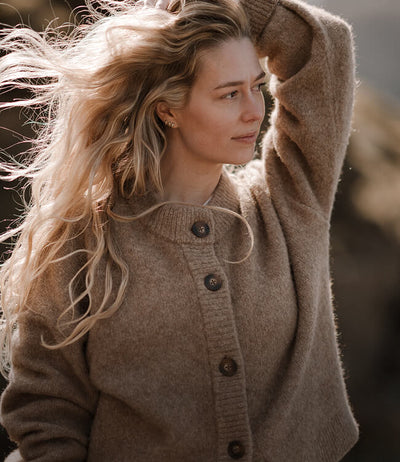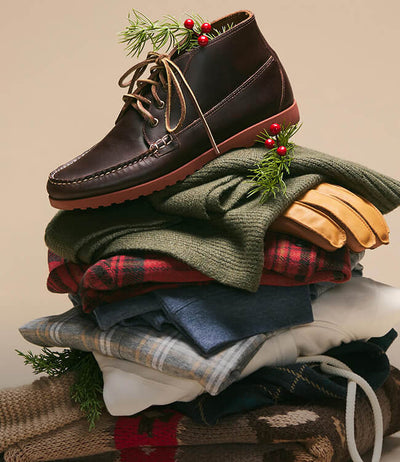Fleece occupies a special place in our hearts. Something about it feels like holiday traditions and morning frost. It’s brisk walks beneath snow-glazed branches and belly laughs around roaring campfires.
Fleece is basically the fabric equivalent of a warm embrace.
But don’t let the fluff fool you. Beyond its plush texture is a story of progress, adventure, and sustainability that spans decades.
The Anatomy of a Fleece CPO

- Relaxed Overshirt Design
- Recycled Polyester
- Snap Closure
- Button Front Closure
- Chest Patch Pockets
Origins
Wool was a critical commodity, as essential as salt or iron. For millennium, pastoralists shorn sheep wool to weave into hardy cold-weather fabric. The Industrial Revolution made this process more efficient than ever.
Fleece was invented in the late 20th century as a synthetic alternative, offering similar insulating properties without the weight or grating itch.
In the 1970s, Massachusetts-based company Malden Mills (now known as Polartec) developed the first synthetic fleece from polyester fibers. This first-of-its-kind fabric, named Polar Fleece, was lightweight, breathable, and quick-drying.

Unlike wool, fleece maintains its warmth even when wet and is much easier to care for, making it a game-changer for outdoor enthusiasts. Synthetic fleece is also significantly more affordable and accessible to a wider range of consumers.
The Birth of High Pile Fleece
While standard fleece revolutionized cold-weather gear, high-pile fleece went a step further.
High pile fleece refers to a type of fleece with a longer, thicker “pile” — the fluffy surface of the fabric that creates extra softness and insulation.

By the 1980s, outdoor brands began experimenting with higher-pile fleece to create even warmer, more luxurious fabrics. This fleece was thicker, plusher, and offered an increased warmth-to-weight ratio, making it ideal for extreme cold. The longer fibers trapped more air, creating better insulation, while still being lighter than wool.
High-pile fleece quickly became a favorite for outdoor adventurers — from mountaineers battling alpine peaks to campers looking for a cozy jacket by the fire. Brands like Patagonia and The North Face helped popularize this style, incorporating high-pile fleece into jackets, vests, and mid-layers.

High Time for the High Pile
By the late 20th century, it became clear that this fluffy fabric wasn’t only functional, it was also stylish. The rugged practicality of outdoor gear began to influence mainstream fashion as consumers embraced an adventurous, laidback look.
In the early 2000s, fleece jackets became a staple in casual wardrobes, favored for their comfort and warmth. High-pile fleece found a home back on the beaten path, a welcome sight in cafes, college campuses, and chilly office boardrooms. Designers used high-pile to accent leg warmers, pants, and boots, establishing fleece in teen culture and street style.
Sustainability and Innovation
Originally made from petroleum-based polyester, fleece initially didn't align with the values of environmentally conscious consumers. In response, brands started experimenting with blends of organic cotton, wool, and even biodegradable fleece to create garments that are kinder to the environment without sacrificing warmth or durability.
Today, many high-pile fleece garments are made from recycled plastic bottles, reducing the reliance on virgin polyester and cutting down on waste. (At Faherty, we’re committed to using responsible materials wherever possible, but especially in our High Pile Fleece CPOs.)
The Fleece Jacket in Modern Fashion
Over the last decade, high-pile fleece has been reimagined by high-end fashion brands, appearing on runways in more tailored silhouettes and bold colors. Luxury labels like Gucci and Balenciaga have taken inspiration from the outdoors, incorporating fleece into oversized jackets and statement pieces, blending comfort with couture.
High-pile fleece has even found a place in streetwear, where its relaxed, cozy vibe perfectly contrasts the urban outdoor aesthetic. Collaborations between outdoor brands and streetwear labels have led to fresh takes on this classic fabric, incorporating vibrant colors, unique textures, and modern cuts.
Cozy, Functional, and Here to Stay
High-pile fleece, with its soft, insulating properties, has proven to be both an enduring and versatile fabric. Whether it’s layered under a shell for winter hikes, thrown over a tee for a casual outing, or dressed up in a fashion-forward statement piece, its appeal lies in its ability to provide warmth and comfort no matter the occasion.
This once purely utilitarian fabric has become an icon of modern casual wear, seamlessly blending function with fashion. And as the world moves toward more sustainable choices, the high-pile fleece is paving the way — offering a perfect balance of coziness, durability, and responsible production.
Fleece At Faherty

Whether you’re hiking, traveling, or lounging, high-pile fleece is a luxurious choice you can feel good about wearing. Its staying power lies in its ability to evolve — not just with trends, but with technology and sustainability in mind.
You’ll find a ton of fun fleece options at Faherty, from blankets to pullovers to CPOs. Our current faves? The Range Fleece CPO & Range High Pile Fleece Lined CPO.
These cool-weather must-haves honor the adventurous spirit of American range wear with elevated, responsibly-made materials that are durable and luscious. We think you’ll like ‘em.


















